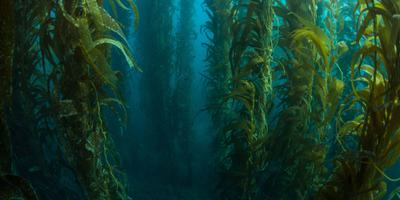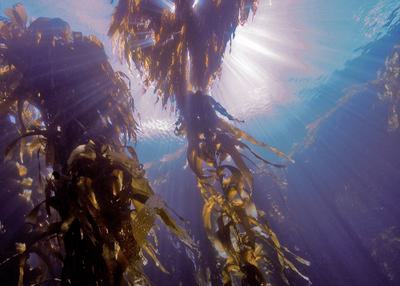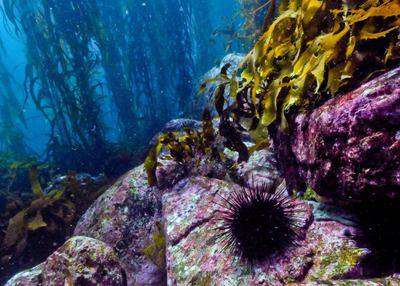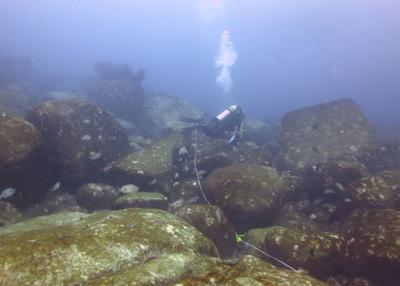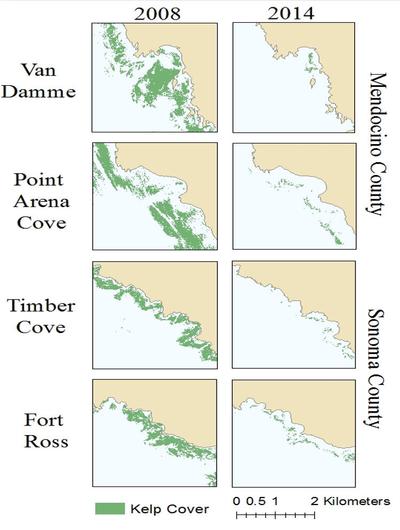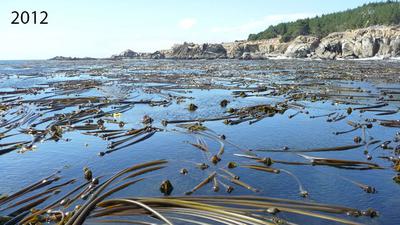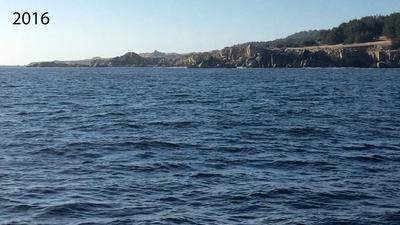Routine summertime spikes in water temperature in eastern Tasmania have pushed kelp forests over the edge.
And in northern California, a series of events that began several years ago has destroyed the once-magnificent bull kelp forests along hundreds of miles of coastline. A brief shutdown of upwelling cycles left the giant algae groves languishing in warm surface water, causing a massive die-off. Meanwhile, a disease rapidly wiped out the region’s urchin-eating sea stars, causing a devastating cascade of effects: Overpopulated urchins have grazed away much of the remaining vegetation, creating a subsurface wasteland littered with shells of starved abalone. Scientists see no recovery in sight.
A 2016 study noted a global average decrease in kelp abundance, with warming waters directly driving some losses. But the researchers said that a characteristic of kelp forest declines is their extreme regional variability. Some areas are even experiencing a growth in kelp forests, including the west coast of Vancouver Island, where an increasing population of urchin-hunting sea otters has reduced the impacts of the spiny grazers, allowing kelp to flourish. Ultimately researchers say, warming ocean waters are expected to take a toll on the world’s kelp forests. The 2016 paper, coauthored by 37 scientists, concluded that “kelp forests are increasingly threatened by a variety of human impacts, including climate change, overfishing, and direct harvest.”
In eastern Tasmania, sea surface temperatures have increased at four times the average global rate, according to Johnson, who along with colleague Scott Ling has closely studied the region’s kelp forest losses. This dramatic environmental change began in the mid-20th century and accelerated in the early 1990s. Giant kelp — Macrocystis pyrifera — does best in an annual water temperature range of roughly 50 to 60 degrees Fahrenheit, according to Johnson. He says routine summertime spikes into the mid-60s pushed the kelp over the edge. First in Australia, and subsequently in Tasmania, the kelp forests vanished. The Australian government now lists giant kelp forests as an endangered ecological community.
The progression of the destruction of a kelp forest in Tasmania by urchins, from left to right. The Australian island state has lost more than 95 percent its kelp forests in recent decades. Courtesy of Scott Ling
As waters warmed, something else also happened. The long-spine sea urchin, which generally cannot tolerate temperatures lower than 53 degrees Fahrenheit, traveled southward as migrant larvae and established new territory in Tasmanian waters. Lobsters — which prey on urchins — had been heavily fished here for decades, and consequently few predators existed to control the invading urchins, whose numbers boomed.
Since the 1980s, long-spine urchins — Centrostephanus rodgersii — have essentially taken over the seafloor in southeastern Australia and northeastern Tasmania, forming vast urchin barrens. An urchin barren is a remarkable phenomenon of marine ecology in which the animals’ population grows to extraordinary densities, annihilating seafloor vegetation while forming a sort of system barrier against ecological change. Once established, urchin barrens tend to persist almost indefinitely.
“For all intents and purposes, once you flip to the urchin barren state, you have virtually no chance of recovery,” Johnson says.
In some places, like the southwestern coast of Hokkaido, in Japan, and the Aleutian Islands, urchin barrens have replaced kelp forests and have remained for decades.
This bodes poorly for eastern Tasmania, where expansive areas in the north have already been converted into barrens. Urchins have not yet overrun southeastern Tasmania. “But we’re seeing the problem moving south, and we’re getting more and more urchins,” says Johnson, who expects roughly half the Tasmanian coastline will transition into urchin barrens. “That’s what we have in New South Wales.”
Warm ocean temperatures, a sea star disease outbreak, and a boom in urchin populations decimated several major kelp beds in northern California between 2008 and 2014. California Department of Fish and Wildlife
A similar scenario is unfolding in northern California, where local divers and fishermen have watched the area’s bull kelp forests collapse into an ecological wasteland. As in Tasmania, the change has resulted from a one-two punch of altered ocean conditions combined with an urchin boom.
The problems began in 2013, when a mysterious syndrome wiped out many of the sea star species of the North American west coast. Sea stars — especially Pycnopodia helianthoides, the sunflower sea star — eat urchins. With the predators abruptly absent in the region, the population of purple sea urchins — Strongylocentrotus purpuratus — began growing rapidly.
By coincidence, a simultaneous onset of unusual wind and current patterns slowed the upwelling of cold, nutrient-rich bottom water, which typically makes the waters of the west coast of North America so productive. Kelp forests, already under attack by armies of urchins, disappeared.
The upwelling cycles have since resumed. “But the system just can’t recover, even with a shift back in water temperature,” says Kyle Cavanaugh, an assistant professor of geography at the University of California, Los Angeles who has studied global kelp ecosystems. “The urchins are just everywhere.”
Divers surveying the seafloor have seen purple urchin numbers jump by as much as 100-fold, according to Cynthia Catton, a biologist with the California Department of Fish and Wildlife who has been surveying the environment since 2002. Urchins — dozens per square meter in places — continue to gnaw away the remnant scraps of the vanishing kelp forests, 95 percent of which have been converted to barrens, Catton says.
Urchins — dozens per square meter in places — continue to gnaw away the remnant scraps of the vanishing kelp forests.
Other animals also depend on kelp, and the region’s red abalone are now starving in droves. The population has collapsed, and the recreational harvest could be banned in the coming year, Catton says. Juvenile fish use kelp as nursery habitat, and certain species of rockfish may see declines in the absence of protective vegetation. Predatory fish, like lingcod, may move elsewhere to hunt. Populations of the commercially valuable red urchin, Mesocentrotus franciscanus, are also being impacted as their gonads — finger-sized golden wedges listed on sushi menus as uni — shrivel away, making the urchins no longer worth harvesting.
An urchin barren is considered to be an “alternative stable state” to the kelp forest ecosystem and is almost invincibly resistant to change. Johnson says that while it takes relatively high urchin densities to graze a kelp forest down to a barren, the animals must be almost eradicated entirely to allow a shift back to a kelp forest. In other words, he says, “The number of urchins needed to create a barren is much greater than the number of urchins needed to maintain it.”
Part of the reason urchin barrens are difficult to reverse is the hardiness of the urchins themselves. Foremost, they are almost immune to starvation, and once they’ve exhausted all vegetation will outlive virtually every other competing organism in the ecosystem. In the urchin barrens of Hokkaido, which formed roughly 80 years ago for reasons that remain unclear, individual urchins have lived in the collapsed environment for five decades, according to a 2014 analysis.
What’s worse, the hungrier urchins get, the more destructive they become. Research has shown that the calcite deposits that form urchins’ jaws and teeth enlarge when the animals are stressed by hunger — a rapid adaptation that allows them to utilize otherwise inedible material.
A bull kelp forest as seen from the surface of Ocean Cove in northern California in 2012 and 2016. Kevin Joe and Cynthia Catton, California Department of Fish and Wildlife
“They’re now eating through barnacles, they’re eating the calcified coralline algae that coats the rocks, they’re eating through abalone shells,” Catton says of the purple urchins in northern California. “The magnitude of their impact increases as their food supply diminishes.”
They become aggressive, too. Whereas urchins in healthy kelp ecosystems tend to dwell in crevices for much of their lives and wait for drifting kelp to come their way, in a barren state they exit their hiding places and actively hunt for food. “They form these fronts, and they graze along the bottom and eat everything,” says Mark Carr, a marine biologist at the University of California, Santa Cruz.
In the kelp forests of Alaska’s Aleutian Islands chain, urchin barrens began forming in the 1980s, causing local declines in various fishes, bald eagles, and harbor seals. The transition began when the population of sea otters started to decline, possibly because of increased predation by killer whales. Green urchin numbers skyrocketed, and the animals destroyed the kelp forests along hundreds of miles of the archipelago. “The densities are getting ridiculous,” says Matthew Edwards, a San Diego State University biologist who has studied the region. “In some places we have hundreds of urchins per square meter.”
In Tasmania, Johnson and Ling are leading an effort to protect areas that haven’t yet been overwhelmed by the long-spine urchin. The best chance they see is to boost localized populations of predatory rock lobsters. Fishery officials are on board with the plan, Johnson says, and have tightly restricted lobster harvest in order to help increase their numbers. Johnson and Ling have also been directing the translocation of large lobsters into test site barrens.
“It’s like seeing a forest you once knew turn into a desert,” says one scientist.
But the measures have been only moderately successful. Ling is currently re-surveying dozens of study sites first assessed in 2001, and he says urchin density has more than doubled in some locations. On relatively small barrens surrounded by healthy reef ecosystems, the scientists have seen progress as translocated lobsters knock down urchin numbers sufficiently to allow some vegetation to grow back.
“But on those extensive barrens, you can pour in as many large lobsters as you like, and they will eat hundreds of thousands of urchins, but they cannot reduce the urchins enough for any kelp to reappear,” he says. “Even if you turned all those urchin barrens into marine protected areas tomorrow, you could wait 200 years and you still wouldn’t get a kelp forest back.”
In central California, kelp forests are still thriving, a fact Carr credits to one animal.
“We have sea otters down here, and they’re voracious predators of urchins,” he says.
Carr, both a research diver and a recreational abalone diver, says he has watched the decline of northern California’s kelp forests with great sorrow.
“It’s like seeing a forest you once knew turn into a desert,” he says. “Not only do you lose all the trees, but all the smaller plants around them die, until there’s nothing left.”
